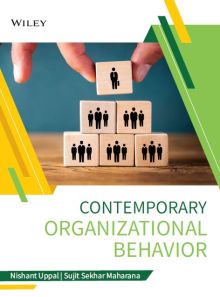Contemporary Organizational Behavior
ISBN: 9789354642593
Publication Year: 2022
For more information write to us at: acadmktg@wiley.com

Description
Contemporary Organizational Behavior is an attempt at realizing that prevalent business realities are starkly different from those of the 1970s and 1980s. A few of these changes are increase in volatility of the environment, rapid pace of technological change, diminishing importance of bureaucracy and rise of alternative organizational structures, a shift away from the concept of “employment for life”, change in the nature of compensation and employee aspirations, a strong shift towards short-term based assignments as opposed to individual yearly assignments, and emergence of new trends.
Preface
About the Authors
Chapter 1 Introduction to Field of Organizational Behavior
1.1 What is Organizational Behavior?
1.2 Factors Affecting Organizational Behavior
1.3 Approaches to Organizational Behavior
1.4 Organizational Behavior Models
1.5 Importance of Organizational Behavior
1.6 Study of External Business Environment
Chapter 2 Individual Behavior, Personality, and Values
2.1 Personality
2.2 Why is Study of Personality Important?
2.3 Types of Personality
2.4 Historical Perspectives on Personality Theory
2.5 Modern Approaches to Personality Theories
2.6 Models of Personality Theories
2.7 Dark Triad Traits of Personality
2.8 Myers–Briggs Type Indicator (MBTI) Model
2.9 HEXACO Model of Personality
2.10 Johari Window
2.11 The Transactional Analysis Theory
2.12 Psychometric Test
2.13 FIRO-B Test
2.14 O*NET
2.15 Emotional Intelligence
2.16 EQ and IQ
Chapter 3 Perceiving Ourselves and Others in Organizations
3.1 What is Perception?
3.2 Perception in Leadership
3.3 Factors Influencing Perceptual Process
3.4 A Live Case: Perception Management at Workplace
3.5 The Attribution Theory of Perception
3.6 Managing Biases
3.7 Types of Attributions
3.8 Theories of Attribution Process
3.9 Social Perception
3.10 Impression Management
Chapter 4 Emotions, Stress, and Job Satisfaction at Workplace
4.1 Workplace Emotions
4.2 Emotions and Mood
4.3 Relationship between Behavior and Attitude
4.4 Workplace Stress
4.5 Job Satisfaction
Chapter 5 Motivation, Organizational Justice, and Job Design
5.1 Definition and Concept of Motive and Motivation
5.2 Applications of Motivation
5.3 Importance of Motivation
5.4 Risks Associated with Lack of Motivation in Organizations
5.5 Theories of Motivation
5.6 Application of Motivational Theory at Workplace
5.7 Role of Managers in Providing Motivation
5.8 Case Study
5.9 Organizational Justice
5.10 Ways to Improve Organizational Justice
5.11 Theories of Organizational Justice
5.12 Effects of Organizational Justice
5.13 Relationship between Organizational Justice and Positive Organizational Behavior
5.14 Employees’ Response to Organizational Injustice
5.15 Handling Responses to Injustice
5.16 Applications of Organizational Justice
5.17 Case Study
5.18 Job Design
5.19 How Job Design Works
5.20 Theories of Job Design
5.21 Models of Job Design
5.22 Importance of Job Design
5.23 Factors Affecting Job Design
5.24 Advantages of Job Design
5.25 Job Design Techniques
5.26 Different Approaches to Job Design
5.27 Issues Faced while Designing Job
5.28 Performance Objectives in Job Design
Chapter 6 Decision-Making
6.1 The Decision-Making Process
6.2 How We Decide What We Decide?
6.3 The Decision-Making
6.4 Nudge By Sunstein and Thaler (Thaler and Sunstein, 2021)
6.5 Rationality
6.6 Intuition
6.7 Emotion
6.8 Decision-Making in the Managerial Context—Individual, Group, and Organizational Behaviour
6.9 Conclusion
Chapter 7 Team Dynamics in Organizations
7.1 Introduction
7.2 Classification of Teams
7.3 Team Effectiveness
7.4 Decision-Making in Teams
7.5 Virtual Teams
Chapter 8 Communicating/Communication in Teams and Organizations
8.1 Introduction
8.2 Models of Communication
8.3 Communication in Teams
8.4 Communication in Organizations
8.5 Communication Channels
8.6 Important Aspects of Organizational Communication
8.7 Barriers in Effective Communication
Chapter 9 Power and Influence at the Workplace
9.1 Introduction
9.2 A General Model of Power (Anderson & Brian, 2014)
9.3 Bases of Power and its Effects
9.4 Power in Organizations
9.4.3 Use of Power
9.5 Other Issues in Organizational Power
9.6 Politics in Organizations
Chapter 10 Conflict and Negotiation in the Workplace
10.1 Introduction
10.2 Models of Conflict Management
10.3 Conflict in Organizations
10.4 Negotiation in Organizations
Chapter 11 Leadership
11.1 Introduction
11.2 Theories of Leadership
11.3 Models of Leadership Effectiveness
11.4 Females in Leadership
Chapter 12 Designing Organization Structures
12.1 Introduction
12.2 Basic Design Strategies
12.3 General Classification of Organizational Designs (Mintzberg, 1979, 1980)
12.4 Factors Affecting Organizational Design
12.5 Important Issues in Organizational Design
Chapter 13 Organizational Culture
13.1 Introduction
13.2 General Models of Culture
13.3 Organizational Climate
13.4 Important Issues in Organizational Culture
Chapter 14 Organizational Change
14.1 Introduction
14.2 Models of Change Management
14.3 A General Model of Organizational Change (Mintzberg and Westley, 1992)
14.4 Important Issues in Organizational Change
Summary
Multiple Choice Questions
Review Questions
References
Index

